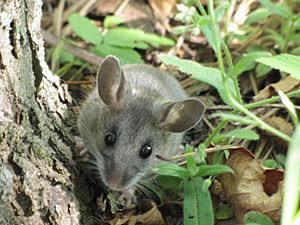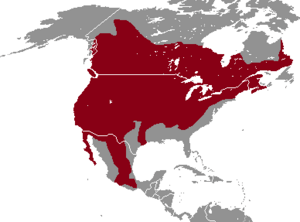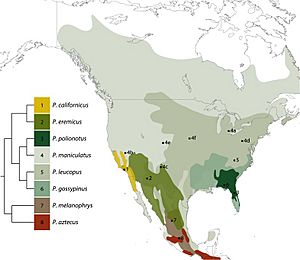Peromyscus maniculatus facts for kids
Quick facts for kids Peromyscus maniculatus |
|
|---|---|
 |
|
| Conservation status | |
| Scientific classification | |
| Genus: |
Peromyscus
|
| Species: |
maniculatus
|
The deer mouse (scientific name: Peromyscus maniculatus) is a small rodent that lives in North America. It's also called the North American deermouse because many different types of Peromyscus mice are called "deer mice." You can find them almost everywhere on the continent, except for the very far north and the southeastern United States.
Deer mice are important because they can carry germs that cause diseases like hantaviruses and Lyme disease. They don't usually get sick themselves, but they can pass these germs to other animals or even people.
This mouse is very similar to the white-footed mouse (Peromyscus leucopus).
Contents
About the Deer Mouse
There are 61 different types, or subspecies, of deer mice. They are all tiny mammals and there are lots of them! The deer mouse is closely related to the white-footed mouse. It's hard to tell them apart just by looking. Scientists often use special blood tests or look at their chromosomes to know the difference.
You can sometimes tell a deer mouse by its long, two-colored tail. It's dark on top and light underneath. Deer mice are often used in science labs because they are clean and easy to care for.
What They Look Like
The deer mouse is a small animal, about 3 to 4 inches (7.6 to 10 cm) long, not counting its tail. They have big, dark eyes and large ears, which help them see and hear very well.
Their fur is soft and can be gray or brown. But all deer mice have a white belly and white feet. Their tails are covered with fine hairs and are also dark on top and white underneath, just like their bodies.
Different types of deer mice have slightly different looks. For example, the ones that live in forests have longer back legs, longer tails, and bigger ears than the ones that live in open fields.
How They Behave
Deer mice are night animals. This means they are active when it's dark and sleep during the day. They make nests out of plant material in places like trees or underground burrows.
A mother deer mouse keeps her babies in her own special area, called a home range. These home ranges can be quite large, from about 2,600 to 32,000 square feet (242 to 3,000 square meters).
Even though each mouse has its own home range, these areas often overlap. When they do, it's usually between a male and a female mouse. Male deer mice tend to have much larger home ranges than females, who are more protective of their space. Mice whose home ranges overlap often recognize each other and interact a lot.
The forest deer mouse is a great climber and likes to live high up in trees. The field deer mouse prefers to stay on the ground, moving between burrows in open areas and avoiding thick plants.
Reproduction and Life Cycle
How They Have Babies
Deer mice often have one male mate with several females. This is called being polygynous. Because of this, males have much larger territories than females. They also live with multiple females. Sometimes, male deer mice might harm young mice if they are left alone.
Even though they usually live alone, in winter, a male and several females might share a nest to stay warm.
When They Breed
Deer mice can have babies all year long. But in most places, they breed from March to October. How much food is available often affects when they breed more than the season does.
For example, in some areas, deer mice bred through December when there was plenty of food like seeds and nuts. But they stopped breeding in June during a year with little food. In other places, they might breed all year, or take a break during the coldest and wettest weather.
Building Nests
Female deer mice build nests using many different things. They use grasses, roots, moss, wool, and even man-made fibers. Male deer mice are sometimes allowed by the female to help with the nest. They help keep the babies warm and together.
Studies have shown that less than half of both male and female deer mice leave their first home to have babies. This means that mice often mate with family members. This also means that genes don't spread very far among deer mice.
Some recent studies suggest that deer mice can show behaviors similar to OCD (Obsessive-Compulsive Disorder). This happens when their gut bacteria change. For example, they might build nests that are much too big. This behavior can be seen within 8 weeks of birth. Building huge nests in a lab, where conditions are always good, is a waste of energy for the mice.
Number of Babies and How Often They Have Them
Deer mice have many babies and are one of the most common mammals in their areas. Pregnancy for a deer mouse lasts from 22 to 26 days.
A typical litter has three to five babies, but it can range from one to nine. Most female deer mice have more than one litter each year. Three or four litters per year is common. Some captive deer mice have had as many as 14 litters in one year! Males usually live with the family and help take care of the young.
How Young Mice Grow
Deer mouse babies are born helpless. They are blind, naked, and can't do much on their own. But they grow very quickly!
They get a full coat of fur by the end of their second week. Their eyes open when they are between 13 and 19 days old. They are fully furred and can live on their own in just a few weeks. Mothers feed their babies milk for 27 to 34 days. Most young mice stop drinking milk when they are about 18 to 24 days old. They reach adult size at about 6 weeks old and continue to gain a little weight after that.
Female mice can start having babies when they are about 48 days old. The youngest recorded was 23 days old. The youngest wild female to have a litter was 55 days old. Scientists think she got pregnant when she was about 32 days old.
Moving Out
Young deer mice usually leave their birth area after they stop drinking milk. This happens before the next litter is born, when they are becoming old enough to have their own babies. Sometimes, young mice stay in their birth area, especially if there isn't much space to breed elsewhere. Most deer mice travel less than 152 meters (about 500 feet) from where they were born to find their own home.
How Long They Live
In a lab, deer mice can live up to 96 months (8 years). On average, females live about 45.5 months and males live about 47.5 months in a lab.
In the wild, many deer mice live less than 1 year. One study found that an entire group of deer mice in a grassland area was replaced by new mice in just one summer. One male deer mouse lived 32 months in captivity. There's even a report of a forest deer mouse that lived 8 years in captivity! Another mouse could still have babies until it was almost 6 years old.
Where They Live
You can find Peromyscus maniculatus all over North America. Most deer mice build their nests high up in large, hollow trees. A deer mouse usually nests alone. But during winter, they might nest in groups of 10 or more to stay warm.
They are very common in the western mountains. They live in wooded areas and places that used to be wooded. Deer mice, especially the field type, are also common in the farmlands of the midwestern United States. In winter, deer mice can be active on top of the snow or under logs.
Deer mice live in many different plant areas. These include grasslands, bushy areas, woodlands, and forests. In one study of small mammals in Colorado and Wyoming forests, the deer mouse was found most often. However, it wasn't always the most common small mammal.
Deer mice were found in four out of six forest types in eastern Washington and northern Idaho. They were the only rodent found in pine forests there. In northern New England, deer mice live in both evergreen and deciduous (leaf-shedding) forests. Deer mice are often the only Peromyscus species found in northern forests. Different types of deer mice use different plant communities and structures. There are two main groups: the prairie deer mouse and the woodland or forest deer mouse.
Where They Hide
Deer mice are often active in open areas. Most types don't make hidden paths like many voles do. In open areas within forests, deer mice tend to go towards the nearest trees. In central Ontario, deer mice used fallen wood as pathways.
Deer mice build nests in burrows they dig in the ground. They also build nests in raised places like piles of branches, logs, rocks, tree stumps, under tree bark, and in hollow parts of trees. Nests have also been found in old buildings and abandoned vehicles. Some nests have been found as high as 24 meters (about 79 feet) above the ground in Douglas fir trees.
Who Eats Them
Deer mice are an important food source for many animals. These include snakes, owls, minks, martens, and other weasel-like animals. Skunks, bobcats, domestic cats, coyotes, foxes, and ringtail cats also hunt them. Deer mice can also get parasites like Cuterebra fontinella.
What They Eat
Deer mice eat many different things, so they are called omnivores. Their main foods are seeds, fruits, insects and other arthropods, leaves, and fungi. Fungi are eaten the least.
Throughout the year, deer mice change what they eat based on what food is available.
- During winter, insects make up about one-fifth of their diet. These include spiders, caterpillars, and true bugs.
- In spring, seeds become available, and they eat a lot of insects too. Leaves are also found in their stomachs during spring.
- In summer, the mice eat seeds and fruits.
- In fall, the deer mouse slowly changes its diet to be more like what they eat in winter.
![]() This article incorporates public domain material from the United States Department of Agriculture document "Peromyscus maniculatus".
This article incorporates public domain material from the United States Department of Agriculture document "Peromyscus maniculatus".
See also
 In Spanish: Ratón ciervo para niños
In Spanish: Ratón ciervo para niños




